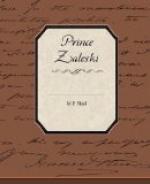meaning one of what the baronet childishly calls “the
lost secrets of the world”: for every successive
inquirer, believing it part of an English phrase, was
thus hopelessly led astray in his investigation.
“Has” is, in fact, part of the word “Hasn-us-Sabah,”
and the mere circumstance that some of it has been
obliterated, while the figure of the mystic animal
remains intact, shows that it was executed by one
of a nation less skilled in the art of graving in
precious stones than the Persians,—by a
rude, mediaeval Englishman, in short,—the
modern revival of the art owing its origin, of course,
to the Medici of a later age. And of this Englishman—who
either graved the stone himself, or got some one else
to do it for him—do we know nothing?
We know, at least, that he was certainly a fighter,
probably a Norman baron, that on his arm he bore the
cross of red, that he trod the sacred soil of Palestine.
Perhaps, to prove this, I need hardly remind you who
Hasn-us-Sabah was. It is enough if I say that
he was greatly mixed up in the affairs of the Crusaders,
lending his irresistible arms now to this side, now
to that. He was the chief of the heterodox Mohammedan
sect of the Assassins (this word, I believe, is actually
derived from his name); imagined himself to be an
incarnation of the Deity, and from his inaccessible
rock-fortress of Alamut in the Elburz exercised a
sinister influence on the intricate politics of the
day. The Red Cross Knights called him Shaikh-ul-Jabal
—the Old Man of the Mountains, that very
nickname connecting him infallibly with the Ul-Jabal
of our own times. Now three well-known facts
occur to me in connection with this stone of the House
of Saul: the first, that Saladin met in battle,
and defeated, and plundered, in a certain place,
on a certain day, this Hasn-us-Sabah, or one of his
successors bearing the same name; the second, that
about this time there was a cordial rapprochement
between Saladin and Richard the Lion, and between
the Infidels and the Christians generally, during
which a free interchange of gems, then regarded as
of deep mystic importance, took place—remember
“The Talisman,” and the “Lee Penny”;
the third, that soon after the fighters of Richard,
and then himself, returned to England, the Loculus
or coffin of St. Edmund (as we are informed by the
Jocelini Chronica) was opened by the Abbot
at midnight, and the body of the martyr exposed.
On such occasions it was customary to place gems and
relics in the coffin, when it was again closed up.
Now, the chalice with the stone was taken from this
loculus; and is it possible not to believe that some
knight, to whom it had been presented by one of Saladin’s
men, had in turn presented it to the monastery, first
scratching uncouthly on its surface the name of Hasn
to mark its semi-sacred origin, or perhaps bidding
the monks to do so? But the Assassins, now called,
I think, “al Hasani” or “Ismaili”—“that
accursed Ishmaelite,” the baronet exclaims
in one place—still live, are still a flourishing
sect impelled by fervid religious fanaticisms.
And where think you is their chief place of settlement?
Where, but on the heights of that same “Lebanon”
on which Sir Jocelin “picked up” his too
doubtful scribe and literary helper?




